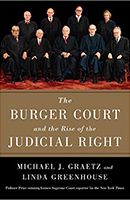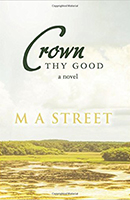Verdict: Touchdown!
 The Burger Court and the Rise of the Judicial Right
The Burger Court and the Rise of the Judicial Right
By Michael J. Graetz & Linda Greenhouse (New York, NY: Simon & Schuster Inc., 2016). 480 pgs. $30. Order, www.simonandschuster.com/books.
Reviewed by Daniel Schmeeckle
The Burger Court and the Rise of the Judicial Right convincingly refutes the notion that the Burger Court was a mere placeholder between the Warren Court and the Rehnquist Court. Not only does the book contextualize the historical importance of the Burger Court, it manages to sidestep the dogma that dominates most books about the Supreme Court.
Want to Review a Book?
Please request a book and writing guidelines from Wisconsin Lawyer managing editor Karlé Lester, at klester@wisbar.org or (608) 250-6127. Reviewers may keep the book reviewed. Reviews of about 500 words are due within 45 days of receiving the book. Reviews are published, space permitting, in the order received and may be edited for length and clarity.
In terms of organization, The Burger Court shines. It contains five parts: Crime, Race, Social Transformation, Business, and The Presidency. Each of the parts chronicles the major decisions and the behind-the-scenes intellectual turmoil that went into shaping those decisions.
The Burger Court’s failings in the realm of social transformation, such as its decisions in Baker v. Nelson and Bowers v. Hardwick, are not defended on the “assumptions defined by the world and time.” Despite the court being a product of its times, The Burger Court’s authors go beyond superficial explanations of judicial philosophy to articulate the human burden the justices shouldered in deciding cases. Regardless of how history ultimately views the Burger Court, it is clear the justices upheld their oaths of office in a principled and laudable manner.
The way in which the book really excels, however, is its ability to connect Burger Court decisions, through the chain of precedent, to contemporary cases. In detailing how the Burger Court paved the way for Citizens United, the authors, in ribald terms, explain how the Burger Court is to blame for the proliferation of erectile dysfunction drugs. As the book explains, the Burger Court’s Buckley decision built the constitutional foundation for corporations to engage in political speech. In doing so, Citizens United, in the authors’ opinions, should not have come as a surprise.
To be clear, The Burger Court is much more than a rote recitation of cases decided during Warren Burger’s stewardship. The authors offer the reader entrance into the court’s chambers with the justices, exposing the human struggles beneath the text of the historic Burger Court decisions. In short, The Burger Court is excellent.
Daniel Schmeeckle, Minnesota 2010, practices with Anderson, O’Brien, Bertz, Skrenes & Golla LLP, Stevens Point.
Verdict: It’s a Keeper
 Turning Points at Trial: Great Lawyers Share Secrets, Strategies and Skills
Turning Points at Trial: Great Lawyers Share Secrets, Strategies and Skills
By Shane Read (Dallas, TX: Westway Publishing, 2016). 562 pgs. $69.95. Order, www.amazon.com.
Reviewed by John A. Becker
Based on the title, Turning Points at Trial, a reader might expect this book to be about famous trials and to include stories about significant events that changed the course of the trial. Instead, the book is about litigation strategies.
The book is divided into seven parts: opening statements, direct examination, cross examination, cross examination of expert witnesses, closing arguments, depositions, and appellate oral argument. Each part has several chapters, dealing with a particular trial that was handled by a particular lawyer. Each chapter contains a combination of some tips from the lawyer, an analysis by the author, and portions of the transcript showing how the lawyer handled a witness, opening statement, or cross examination.
All of the lawyers referenced in the book are skilled trial lawyers. Each chapter contains an excellent discussion of what the lawyer was trying to accomplish in the opening statement, cross examination, or other part of the trial. The techniques and strategies used by the lawyers are exemplified by the trial or deposition transcripts. The portions of the transcript are very helpful in seeing how the lawyer accomplished his or her objective.
This book is like going to an advanced seminar on litigation and listening to a prominent lawyer giving a presentation on a particular subject. Most lawyers attending a seminar hope to get something productive out of each presentation. Any lawyer reading this book will get something productive out of each chapter.
Young lawyers will learn very good techniques on all aspects of litigation, from depositions to appellate oral argument. Even the most experienced trial lawyers will get something beneficial out of each chapter.
Overall this is a very good book with many good pointers and examples on all aspects of trial advocacy. The drawback is that it is not an easy reference book. It is much like attending a seminar. The book contains the type of information that you will store in the back of your mind as general knowledge but not the type that you will pull out for reference when preparing for trial. I would recommend the book for any young lawyer who wants to be a good trial lawyer.
John A. Becker, U.W. 1982, is in practice with Becker French & Durkin in Racine.
Verdict: A Tree Died For This?
 Crown Thy Good
Crown Thy Good
By M A Street (Melt Water Press, 2016). Novel. 384 pgs. $13.99. Order, www.amazon.com.
Reviewed by Amanda Pirt Meyer
Crown Thy Good has the potential to be an appealing book to those who enjoy modern fiction but fails to reach that level. The novel follows Bowman Carter, a disgraced district attorney from North Carolina, from downfall to redemption. This is a predictable narrative that fits snugly into the redemption-quest trope. While the impetus of Carter’s calamitous downfall is quite shocking, it is the only thrilling and fast-paced note of this novel. Instead, the story is a verbose, languid tale. This style is perhaps an intentional reflection of the book’s setting, painting a stereotypical slow Southern life. As a relocated Southerner, and therefore more critical than the typical reader, I was put off by the repetitive and overt “we are in the South” ideas and language employed.
The book is billed as containing a handful of colorful characters who help Carter through his rehabilitation. These characters are interesting at times but are largely caricatures of the humans one might find in a modern version of this quest trope. My characterization is, in part, due to the author’s commanding vocabulary, which is admirable but flowery. Given the length and detailed intensity of the physical descriptions corresponding to each character, I imagine that the author spent a great deal of time concocting them, but to little gain.
Perhaps the best note that I can provide to a potential reader is that this author has published other Christianity-focused books before this. To that end, one of the primary characters in this novel is an occasional lay preacher to the huddled masses. After his introduction, every chapter features a short philosophical sermon. I eventually found myself quickly skimming these passages to get back to the plot. If these discourses were limited or removed, the book would gain focus. Surprisingly, this book also contains sex scenes. With that addition, I feel the audience for this book is further limited.
While I applaud the author’s attempt to modernize a literary cliché, I’m personally not inclined to seek out this author’s other work and find this book difficult to recommend.
Amanda Pirt Meyer, Marquette 2011, is an attorney at Becker Law Office S.C., Madison, practicing Social Security Disability law.
